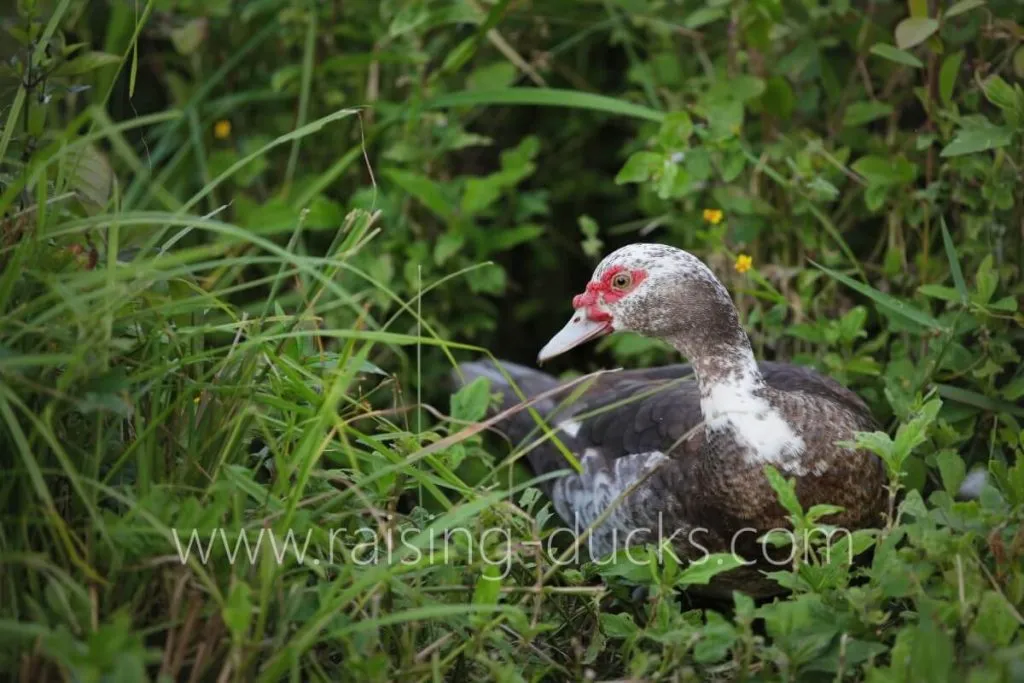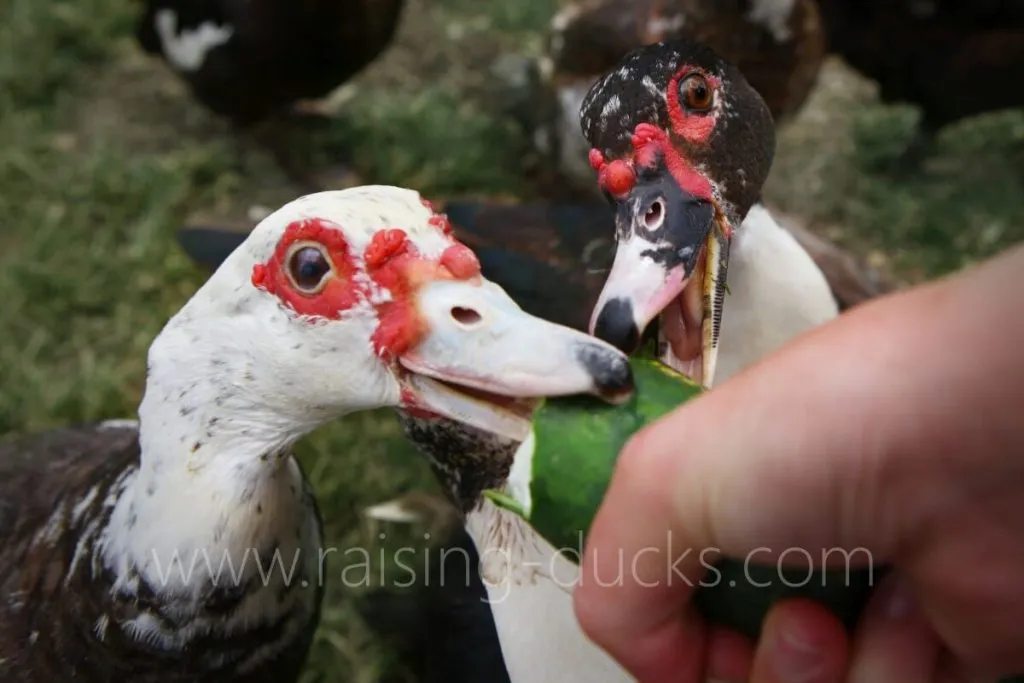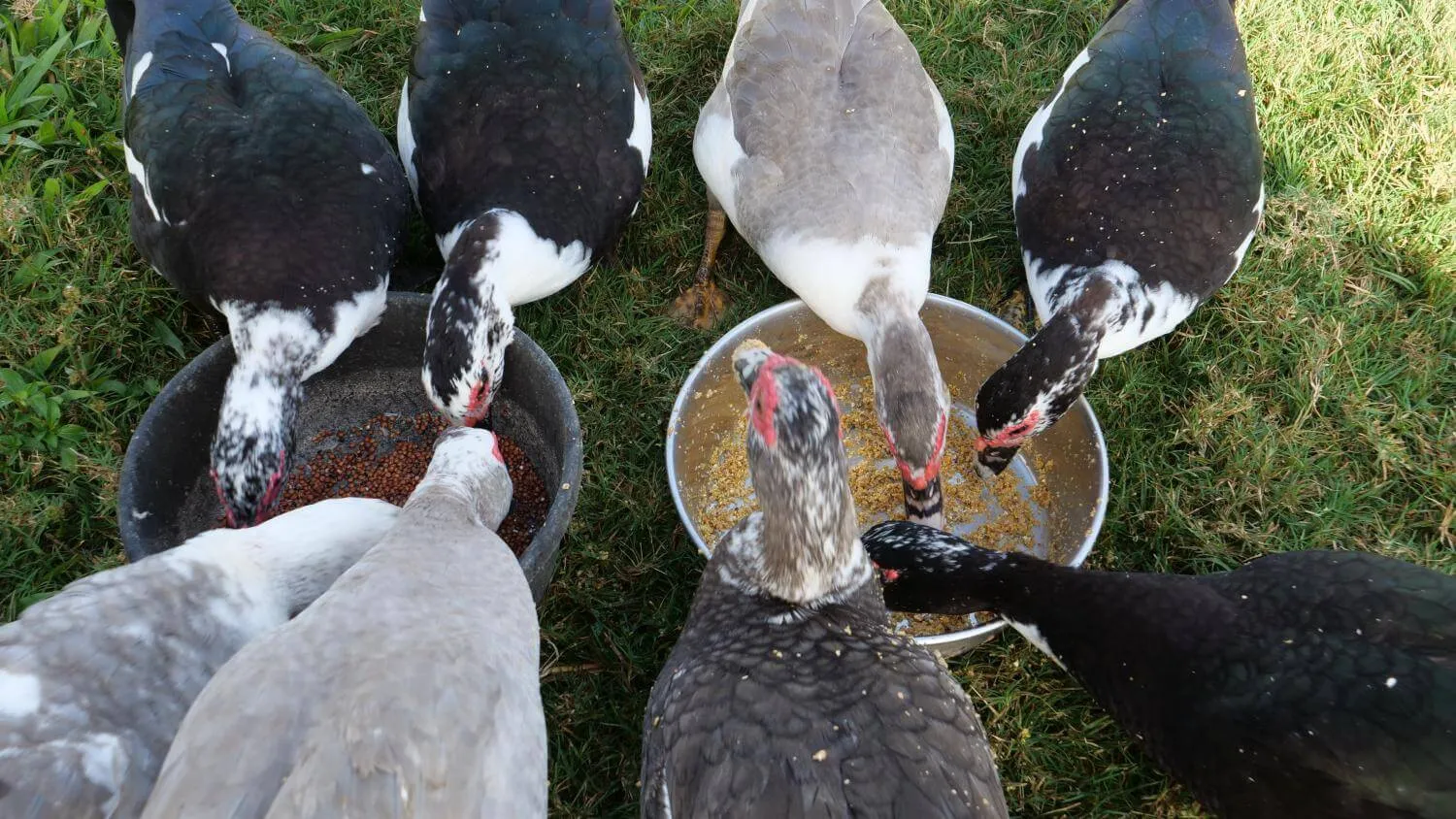One of the biggest decisions new duck owners have to make is how they’re going to feed their ducks. It’s a complicated subject, but here’s a quick guide to feeding ducks for the backyard/pet duck owner or hobby farmer/homesteader.
Disclosure: This post contains affiliate links. As an Amazon Associate, I earn a commission if you purchase something through a link on this post, at no additional cost to you.
Duck feed: which type?
In most cases, premixed commercial feed should comprise the majority of your ducks’ diet. It’s similar to dog kibble, containing a balanced mix of all the nutrients, minerals, and vitamins your ducks need. It can be used as your ducks’ sole ration.
Feed formulated specifically for ducks or waterfowl is best for ducks. Unfortunately, it may not be available where you live.
The second best option is chicken feed. The primary difference between duck and chicken dietary needs is that ducks need more niacin, especially while they’re ducklings. With the addition of niacin, chicken feed works fine for ducks.
For adult ducks, use layer feed, which has added calcium and often is around 16-18% protein.
For all-male flocks, use maintenance feed, grower feed, or all-flock/flock raiser feed. Layer feed is too high in calcium for them. Most people I know feed layer feed to their entire flock, even the drakes, but it’s not ideal.
For ducklings, use duckling feed if you can get it, or chick feed, preferably unmedicated. Many sources say medicated feed is dangerous for ducklings, which used to be true. The medications used nowadays have not been found to be dangerous to ducklings, but still, you may want to play it safe, or you may want to stay away from medications anyway. The medication is to prevent or reduce the chance of coccidiosis, which ducklings do not have trouble with, so there is no reason to give them medicated feed anyway. Read more about feeding ducklings here.
Mash, crumbles, or pellets?
Feed comes in three basic forms: mash, crumbles, and pellets.
Mash
Mash is finely ground and often powdery. It’s all right for chickens, but for ducks, it’s like eating flour. They need to have ample water close by when eating mash or they could choke on it. Even better, wet the mash. Mash is also the messiest and most wasteful, for two reasons:
1. If it’s dry, ducks will often grab a mouthful, run to the water, and drink it down. A lot of the mash then falls into the water and sinks to the bottom.
2. It’s easily spilled and slung around, and it’s too finely ground to be able to be eaten off the ground or bedding.
Mash is the worst option for ducks, but if you have to use it, I recommend wetting it.
Crumbles
Crumbles are ground less finely, so they’re less messy and easier for ducks to eat. I still recommend wetting/soaking crumbles.
The pieces are still small enough for ducklings to eat. This is the best option for ducklings.
Pellets
Pellets are exactly that. They are the least messy, since ducks can easily pick every last pellet off the ground.
Ducklings can’t eat pellets, but for adult ducks, this is the best option.
Calcium
Since eggshells contain so much calcium, adult female ducks often need supplementary calcium. Even if they’re eating layer feed that already has extra calcium, it’s a good idea to offer your ducks free-choice calcium, in the form of soluble grit: limestone or oyster shell. Crushed-up eggshells are another option. Don’t mix it with their feed; offer it on the side where they can eat it as they please.
Grit
Ducks don’t have teeth, but they do have a gizzard. This is a powerful, muscular sac that contracts and grinds up their food. However, it doesn’t work if they don’t have small, sharp stones in their gizzard. So from time to time, ducks will eat small rocks.
If your ducks free range, they can probably find their own rocks.
If their area is limited, you’ll have to provide grit yourself (free-choice, like the calcium). What you want is insoluble granite grit (soluble granite grit is used as a calcium source):
For adult ducks:
For ducklings:
Niacin
If you’re feeding ducks chicken feed, you may need to add niacin (vitamin b3).
For ducklings, this is pretty much a must. Ducklings will easily and quickly go lame if they become niacin deficient.
Some people continue to add extra niacin to their ducks’ feed when they’re adults, but it’s not essential, especially if they free-range or forage a lot.
Niacin can be provided in the form of brewer’s yeast, niacin tablets, or liquid niacin.
Do NOT get flush free, no flush, slow release, or extended release niacin. These will do no good for ducklings. It can be difficult to find the proper type of niacin, but here’s one product that is not flush-free:
Liquid niacin:
Brewer’s yeast:
Forage

There’s not much ducks like better than foraging for their own food. The more space you can give them, the better. If given ample high-quality forage, ducks can find 50-75% or perhaps even more of their own food.
If you want to maximize the amount of food your ducks can find, there’s a lot you can do to improve their forage, such as planting nutritious grasses and weeds. Amaranth and comfrey are two weeds that are highly nutritious for ducks.
Treats

Everyone loves feeding ducks treats. And the ducks, of course, love getting treats.
Treats can be a healthy, fun addition to your ducks’ diets. However, they can also lead to deficiencies and health problems if not fed carefully.
In general, to avoid upsetting the balance and causing deficiencies, treats should comprise less than 10% of your ducks’ diet.
If you feed a wide variety of treats, then the chance of it causing problems is much lower. But if you primarily feed, say, peas and strawberries, then don’t do it every day and feed it in limited quantities.
Read more about giving ducks treats:
When and how often to feed ducks
Free-choice access 24/7
Some people make sure their ducks always have access to feed.
Pros:
- You’ll never worry about underfeeding your ducks.
- You don’t have to feed them every day, if you have a feeder with a large hopper.
Cons:
- Birds, mice, and other animals may steal food, especially if your ducks aren’t in a fully enclosed area.
- The ducks may eat more than they really need, unnecessarily raising your feed bill. They may forage less.
- You only have a vague idea how much they’re eating and you may not notice if a duck suddenly stops eating.
- Keeping the coop clean is more difficult if ducks are eating and drinking a lot during the night.
- This is not a good way to feed Pekins. They need to be put on a diet or they are likely to become overweight and crippled.
- The food can’t be wet. If you soak or ferment your ducks’ feed, it should be consumed quickly.
If you have young ducklings, they must have food available 24/7. Even Pekin ducklings should have food all the time for their first two weeks.
If your ducks can’t forage, they should have food available 24/7 or at least all day.
Free-choice access for the day
If you don’t want food in the coop to reduce mess, it’s fine to give your ducks food during the day only. By the time ducklings are two weeks old, they should be able to go all night without food.
Two feedings a day
In many cases, feeding ducks twice a day is the best option, usually with one morning and one evening meal.
Pros:
- Scheduled feedings save money, since the ducks will eat a little less and you won’t be feeding all the neighborhood critters.
- You won’t be attracting unwanted animals to your ducks’ yard.
- Feeding times are a great opportunity to check on all of your ducks. They will come running excitedly for their meal, so you can see all of them and make sure they’re all healthy and have an appetite.
Cons:
- It’s more time-consuming.
- If your ducks don’t have much forage available, they may get hungry.
To be sure you’re not underfeeding your ducks, offer them as much food as they can clean up within 15 minutes.
When ducklings are at least two weeks old, you can start feeding them two or three times a day.
One feeding a day
This is only an option if your ducks get to forage a lot, or if the single feeding is quite large so they can finish it over several hours.
This is more or less what I do: one main feeding a day, in the evening. My ducks free-range and find a lot of their own food. They are in mobile shelters for the night, so mess in the “coop” is not an issue. Also, feeding them in the evening, in their night shelters, gives them an incentive to go to their shelters for the night.
I give them enough food to last them all night. So essentially, they have two feedings a day, because they have a meal during the evening when I give it to them, and then they snack during the night and during early morning. Sometimes they still have a little left when I let them out, which they usually finish sometime during the morning.
Ducklings must be at least four weeks old before they’re limited to one feeding a day.
How much do ducks eat?
How much you feed your ducks depends primarily on the breed and how much they forage, but most ducks will eat approximately 4-8 ounces a day.
Large meat Pekins without access to forage can eat up to a pound a day
My birds (a mixed flock of Muscovy ducks, geese, and chickens) eat around 1/5 of a pound (3.2 oz) of feed per day each. As I’ve mentioned, they find a lot of food free-ranging.
Feeders
A good feeder minimizes mess, stays clean(ish), doesn’t break or tip over easily, and is easy to fill and clean.
Chicken feeders often consist of a large hopper that gradually empties into a trough below. These work okay for ducks, but they’re quite messy. Ducks will spill a lot of the feed, and they will also wet the feed in the troughs, which can clog them up and cause the wet feed to mold.
Also, if you ferment or wet your ducks’ feed, these gravity feeders just don’t work.
I actually prefer bowls. Yes, the ducks like walking in and standing in their food bowls, and sometimes they poop in them. But I don’t find that to be a big problem. They spill less food if they eat out of bowls. Bowls are also easy to fill and clean.

I often use the dishes that go under flowerpots as duck feed pans. We have a lot of them (since we usually don’t use them under our flowerpots). They’re not ideal, as they can be flipped upside down and break fairly easily, but we have them handy, so we use them.
My favorite feed pan is a large metal dog bowl. They don’t break, are difficult to flip over, and they’re easy to fill and clean.
Leave a comment
Your email address will not be published.